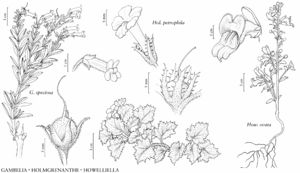Difference between revisions of "Holmgrenanthe petrophila"
Syst. Bot. Monogr. 5: 54. 1985.
FNA>Volume Importer |
imported>Volume Importer |
||
| Line 70: | Line 70: | ||
|publication year=1985 | |publication year=1985 | ||
|special status=Illustrated;Endemic;Conservation concern | |special status=Illustrated;Endemic;Conservation concern | ||
| − | |source xml=https:// | + | |source xml=https://bibilujan@bitbucket.org/aafc-mbb/fna-data-curation.git/src/bb6b7e3a7de7d3b7888a1ad48c7fd8f5c722d8d6/coarse_grained_fna_xml/V17/V17_96.xml |
|genus=Holmgrenanthe | |genus=Holmgrenanthe | ||
|species=Holmgrenanthe petrophila | |species=Holmgrenanthe petrophila | ||
Revision as of 20:28, 27 May 2020
Plants 5–12 cm, cespitose. Stems brittle. Leaves: petiole 12–27 mm; blade orbiculate to reniform, 12–35 × 14–27 mm, apex spinulose. Pedicels ascending, 1–4 mm, glandular-puberulent to glandular-villous. Flowers: sepals falcate, 9–13 × 2–3 mm, margins spinulose, glandular-villous; corolla tube 20–24 mm, glandular-villous, throat open, palate not inflated, abaxial plicae dark yellow with ligulate hairs; lobes: abaxial projecting, adaxial erect, equal, rounded, 7–12 mm; stamens included, filaments incurved, yellow at base, abaxial 12–14 mm, adaxial 7–9 mm, pollen sacs oblong; ovary with a T-shaped septum; style included, terete, 9–10 mm, stigma recurved. Capsules globular, 8–10 mm. Seeds 2–3 mm, surface foveolate.
Phenology: Flowering Apr–Jun.
Habitat: Calcareous canyon walls.
Elevation: 700–1800 m.
Discussion
Holmgrenanthe petrophila is known from the limestone walls of Fall and Titus canyons in the Grapevine Mountains in Death Valley National Monument, Inyo County.
Selected References
None.
